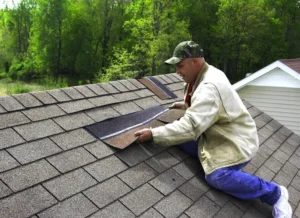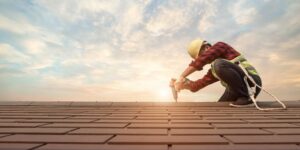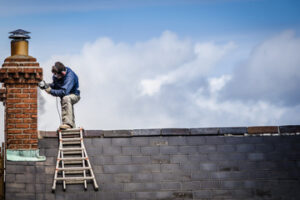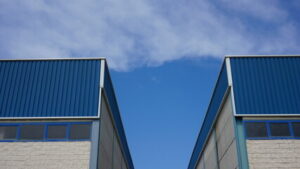Roofs protect buildings from rain, snow, sunlight, and temperature extremes. They come in many shapes and sizes, from roof to domed, to accommodate structural requirements and aesthetic preferences.
Rafters or pre-fabricated trusses support a deck of sheathing boards or plywood. The shingles, shakes, or tiles are placed on top. For more information just visit Roofing Round Rock.

The roof protects the rest of the home from rain, snow, sunlight, wind, and extreme temperatures. It provides a barrier against water and other elements that can cause damage and encourage the growth of mold, mildew, and other harmful substances. A sturdy, well-designed roof is one of a homeowner’s best investments.
Depending on where a person lives, specific weather conditions can affect the integrity of a home’s roof. Heavy rains, thunderstorms, hurricanes, high winds, and snow can all affect roofing materials. Many roofing systems are designed to resist these effects, though some are better suited for some climates than others.
Home improvement experts at Certified Contractors Network explain that picking the right roofing for a particular area can help prevent problems during severe weather events. Homeowners may also consider extra insurance coverage to help pay for repairs and restoration in a catastrophic storm.
The ice and water guard is an underlayment membrane developed to prevent ice dams from forming on the roof. It is self-sealing, waterproof, and adds a layer of protection against water leaks. It can be placed under shingles or other roof coverings, and it can maintain the fire rating of the underlying materials. Building codes sometimes require this type of underlayment. It is available in various thicknesses and can help keep the roof’s underlayment from exposure.
Energy-efficient roofing provides a great opportunity for homeowners to save money on energy costs. Heating and cooling typically account for half of a household’s energy consumption, and choosing the right roofing materials can help reduce these costs.
A roof’s energy efficiency depends on several factors, including color, materials, and coatings. Lighter colors reflect more solar radiation than darker ones, and certain coatings can boost a roof’s reflective properties. In addition, a roof’s thermal performance is determined by its insulation value. A well-insulated roof will slow heat transfer between a hot attic and temperature-controlled living spaces, reducing cooling expenses.
The insulating power of a roof can also be enhanced by adding additional layers of insulation underneath shingles or tiles. Modern insulating materials, such as spray foam and rigid-foam boards of polyiso or polystyrene, provide high R-values that can significantly cut energy transfer and associated greenhouse gas emissions. Often, these materials can be used in place of traditional styrofoam or fiberglass batt insulation.
Choosing an energy-efficient roofing material may also be rewarded with rebates or tax credits. For example, in California, residents who increase the R-value of their roofs can receive a credit on their state taxes. Felt underlayment is also an effective way to increase the R-value of a roof while maintaining or increasing its fire rating.
Homeowners can improve their roof’s energy efficiency by ensuring adequate ventilation. A well-ventilated attic can prevent excessive temperatures from overworking a home’s air conditioning system in summer and help prevent excess heat from building up in winter.
Proper attic ventilation is particularly important for homes in warm climates, and it can be improved at any time during a reroofing project. Adding intake vents positioned in the soffit and exhaust vents placed higher up on the roof will encourage the natural flow of cool air into an attic, keeping it from overheating and transferring that heat to living spaces below. This can significantly reduce a homeowner’s energy bills. In addition, if an existing home is undergoing a reroofing project, adding more shingles or tiles with reflective properties can further improve its energy efficiency.
Aesthetics is a term that encompasses a wide range of philosophical concerns. It can be described as the study of beauty, taste, and art. In some cases, it can also explain how people perceive the world around them. While many philosophers have made some forays into aesthetic concerns, the full development of the field began in the eighteenth century.
The earliest philosophical attempts to deal with aesthetics focused on issues related to the philosophy of art. Later, the scope of the field grew to include all forms of artistic expression. In the early twentieth century, there was a shift towards an interest in pure aesthetic concepts. This is considered one of the major developments in the field’s history.
In the nineteenth century, several different theories of aesthetics were developed. These included rationalist and naturalistic approaches. However, other schools of thought emerged in the twentieth century that challenged these approaches. One of the most important of these was the new critical school, which argued that an author’s intention was irrelevant to the analysis of a literary work.
Many of the philosophies of aesthetics today focus on human experience and reaction to art and nature. They try to understand what makes certain art and nature appealing and how they can be judged and appreciated. It is important to remember that these theories are based on the experiences of individual humans and thus will always be somewhat subjective.
Some scholars have tried to find universals in aesthetics, concepts that are shared by all human beings. These may relate to common emotions, cultural norms, or biological processes. A particular response to a work of art or nature might be shared by two people who have very different cultures and experiences. Consequently, it is challenging to come up with a single definition of aesthetics. Nevertheless, it is important to consider the concept of beauty and how we respond to it.
Inner roof drains are designed to remove water from the building’s interior. They can be used on both flat and low-slope roofs. They are often topped with filters to keep leaves and other debris from blocking them. These are more expensive than different types of drains, but they are highly effective at preventing water from collecting on the roof.
If you find that the water on your roof is still there for more than a day after a rainstorm, it’s time to call in a roofing professional. A blocked drain or gutter may cause the accumulated water. It could also be a sign of structural damage from a recent storm. A roofing professional can check the drainage system and clean out any blockages.
A properly functioning drainage system is critical for the health of your home or business. Water on the roof can rot shingles and tiles, weakening the structure of your home or office. If the drains are clogged, the roof can become unstable and collapse. Clogged gutters can also cause flooding around your property.
The roof is the top part of a building and takes on much of the burden of protecting it from rain, snow, sunlight, wind, and other elements. It must do so because a leaky roof can lead to the house’s interior becoming wet and damaged. Roofs are made from various materials and come in different shapes, depending on the design and style of the building.
Besides protecting the structure from weather, the roof prevents debris from entering a person’s home. When someone chooses to have their roof redone, picking out the right covering is an important decision that they must make. There are several roof covers, and considering energy efficiency is also a good idea. Lighter-colored roof coverings will reflect the sun’s rays, helping to reduce the amount of heat absorbed into the home.
Some of the most common roof coverings are shingles, which can be found in many colors and styles. They are usually composed of a waterproof asphalt base with ceramic granules. Another popular type of roofing is flat roof tiles. These are often made from concrete, clay, or plastic. They can be rolled, glued, or fixed using other methods to form a layer over the underlying surface.
There are other types of roof coverings as well, such as thatch and solar shingles. These tend to be less durable than shingle roofs, but they are very energy efficient. They are also lightweight and easy to install.
Other roof covers include corrugated iron sheets, galvanized steel, and lightweight roofing. These are usually used in rural areas or for industrial buildings. They are easy to install and can be rolled or cut into shapes. The only disadvantage is that they are quite brittle and last only briefly.
When choosing a roof covering, it is important to note that some have strict fire-resistance ratings. For example, a roof that is rated Class “A” must pass the following tests:



